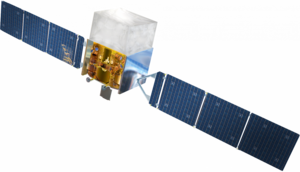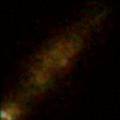Fermi Gamma-ray Space Telescope facts for kids
 |
|
| Names | Gamma-ray Large Area Space Telescope |
|---|---|
| Mission type | Gamma-ray astronomy |
| Operator | NASA · U.S. Department of Energy |
| Website | Fermi.GSFC.NASA.gov |
| Mission duration | Planned: 5-10 years Elapsed: 17 years, 6 months, 24 days |
| Spacecraft properties | |
| Manufacturer | General Dynamics |
| Launch mass | 4,303 kg (9,487 lb) |
| Dimensions | Stowed: 2.8 × 2.5 m (9.2 × 8.2 ft) |
| Power | 1,500 W average |
| Start of mission | |
| Launch date | 11 June 2008, 16:05 UTC |
| Rocket | Delta II 7920-H #333 |
| Launch site | Cape Canaveral SLC-17B |
| Contractor | United Launch Alliance |
| Orbital parameters | |
| Reference system | Geocentric |
| Regime | Low Earth |
| Semi-major axis | 6,912.9 km (4,295.5 mi) |
| Eccentricity | 0.001282 |
| Perigee | 525.9 km (326.8 mi) |
| Apogee | 543.6 km (337.8 mi) |
| Inclination | 25.58° |
| Period | 95.33 min |
| RAAN | 29.29° |
| Argument of perigee | 131.16° |
| Mean anomaly | 229.00° |
| Mean motion | 15.10 rev/day |
| Velocity | 7.59 km/s (4.72 mi/s) |
| Epoch | 23 February 2016, 04:46:22 UTC |
 |
|
The Fermi Gamma-ray Space Telescope (also called Fermi) is a special space telescope. It studies the universe by looking at gamma rays. Gamma rays are the most powerful type of light.
Fermi orbits Earth in a low Earth orbit. Its main job is to map the entire sky. It looks for super-energetic events like active galactic nuclei (bright centers of galaxies), pulsars (spinning stars), and other powerful sources. It also helps scientists learn about dark matter.
Fermi has another instrument called the Gamma-ray Burst Monitor (GBM). This part of the telescope watches for sudden, powerful flashes of gamma rays called gamma-ray bursts. It also studies solar flares from our Sun.
The telescope is named after Enrico Fermi, a famous scientist who studied high-energy physics. It was launched on June 11, 2008, by a Delta II rocket. Many countries, including the United States, France, Germany, Italy, Japan, and Sweden, worked together on this mission. Fermi is the most sensitive gamma-ray telescope ever put into space.
Contents
How Fermi Works
Fermi has two main science tools: the Large Area Telescope (LAT) and the Gamma-ray Burst Monitor (GBM).
The Large Area Telescope (LAT)
The LAT is like a super powerful camera for gamma rays. It can detect photons (tiny particles of light) with very high energy, from 20 million to 300 billion electronvolts. It can see about 20% of the sky at one time. The LAT helps scientists create maps of the gamma-ray sky.
The Gamma-ray Burst Monitor (GBM)
The GBM has 14 special detectors. These detectors can spot gamma-ray bursts across almost the entire sky that isn't blocked by Earth. It looks for gamma rays in a different energy range, from 8 thousand to 30 million electronvolts.
Spacecraft Operations
The company General Dynamics designed and built the spacecraft that carries these instruments. Fermi flies in a low, circular orbit around Earth. It takes about 95 minutes to complete one trip around our planet.
Normally, Fermi keeps its instruments pointed away from Earth. It also rocks slightly to cover more of the sky. This way, it can sweep across most of the sky about 16 times every day! Sometimes, scientists can also tell the spacecraft to point at a specific target they want to study closely.
Before launch, both the LAT and GBM went through many tests. They were shaken, put in a vacuum, and exposed to very hot and very cold temperatures. This made sure they could handle the harsh conditions of space.
All the data Fermi collects is available to the public online. Scientists and even students can use this information to learn more about the universe.
Renaming the Telescope
When it was first launched, the Fermi Gamma-ray Space Telescope was called the Gamma-ray Large Area Space Telescope, or GLAST.
In 2008, NASA held a public contest to give GLAST a new name. They wanted a name that would be exciting and easy to remember. On August 26, 2008, GLAST was officially renamed the "Fermi Gamma-ray Space Telescope." This was done to honor Enrico Fermi, the scientist who helped start the study of high-energy physics.
Mission Goals
NASA planned for the Fermi mission to last at least five years, but hoped it would work for ten years. It has already lasted much longer!
The main goals of the Fermi mission are:
- To understand how particles get super-fast in places like active galactic nuclei, pulsars, and supernova remnants (what's left after a star explodes).
- To figure out where all the gamma rays in the sky come from, especially those from unknown sources.
- To study how gamma-ray bursts behave at very high energies.
- To search for clues about dark matter and the early universe. For example, by looking for extra gamma rays from the center of our Milky Way galaxy.
- To look for signs of tiny, evaporating black holes that might give off gamma rays.
Amazing Discoveries
Fermi has made many exciting discoveries since it launched.
Pulsar Discovery
One of Fermi's first big discoveries was finding a pulsar in a supernova remnant called CTA 1. This pulsar was special because it seemed to only give off gamma rays. It spins very fast, sweeping past Earth every 316.86 milliseconds. This pulsar is about 4,600 light-years away from us.
Most Powerful Gamma-ray Burst
In September 2008, Fermi recorded a gamma-ray burst called GRB 080916C. This burst was the most powerful ever measured! It had the energy of about 9,000 regular supernova explosions. The material shot out from this blast moved at an incredible speed, at least 99.9999% the speed of light. This event showed the greatest total energy, fastest motions, and highest initial energy ever seen from a gamma-ray burst.
Cosmic Rays and Supernova Remnants
In 2010, Fermi helped scientists confirm that supernova remnants act like giant particle accelerators. This means they speed up cosmic particles to very high energies. This was one of the main things Fermi was designed to find out!
Mysterious Gamma-ray Background
In 2010, Fermi showed that active galactic nuclei are not the main source of all the gamma-ray background radiation we see. They produce some, but less than 30%. This means scientists are still looking for what causes the other 70% of gamma rays. It could be star-forming galaxies, colliding galaxies, or even interactions of dark matter.
Giant Fermi Bubbles Around the Milky Way
In November 2010, Fermi discovered two huge bubbles of gamma rays and X-rays around our own Milky Way galaxy. These "Fermi bubbles" stretch about 25,000 light-years above and below the center of the galaxy. They were hard to see before because of a "fog" of gamma rays in the galaxy, but scientists found a way to spot them.
Highest Energy Light from the Sun
In 2012, Fermi saw the highest energy light ever detected from a solar flare (a huge explosion on the Sun). The LAT detected gamma rays with two billion times the energy of visible light! This set a new record for the most energetic light seen during a solar flare.
Terrestrial Gamma-ray Flashes
Fermi has also observed many terrestrial gamma-ray flashes. These are powerful bursts of gamma rays that come from thunderstorms on Earth. Fermi discovered that these flashes can create an enormous number of positrons (anti-electrons), far more than scientists expected.
GRB 130427A
On April 27, 2013, Fermi detected GRB 130427A, another gamma-ray burst with one of the highest energy outputs ever recorded. It included a gamma ray with over 94 billion electron volts, breaking Fermi's previous record by more than three times!
Gamma-ray Burst with Gravitational Waves
On August 17, 2017, Fermi's GBM detected a gamma-ray burst called GRB 170817A. Just two seconds before this, the LIGO observatory detected gravitational waves (ripples in spacetime) from the same area of the sky. This was a huge moment! It was the first time scientists had seen both gravitational waves and electromagnetic radiation (like gamma rays) from the same event. This event was caused by two neutron stars colliding.
Learning More About Fermi
Education and public outreach are very important parts of the Fermi project. The main Fermi education website, glast.sonoma.edu, has many resources for students, teachers, and anyone interested in space. NASA's Education and Public Outreach group at Sonoma State University helps run these resources.
Images for kids
-
A cycle of pulsed gamma rays from the Vela pulsar, created from photons detected by Fermi's LAT instrument.
See also
 In Spanish: Telescopio Fermi para niños
In Spanish: Telescopio Fermi para niños







